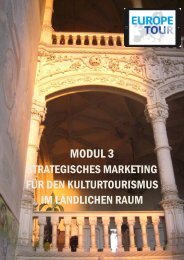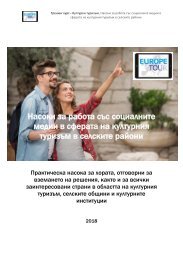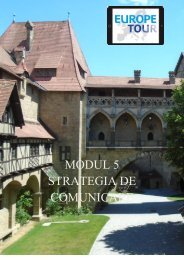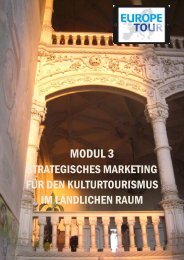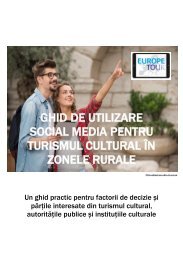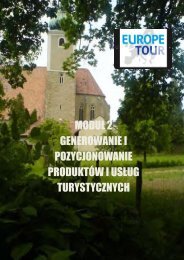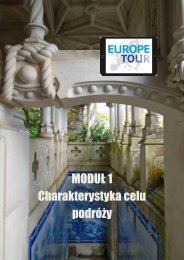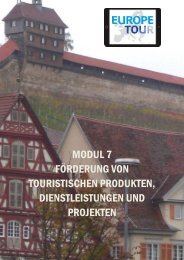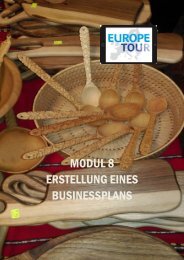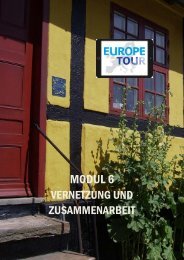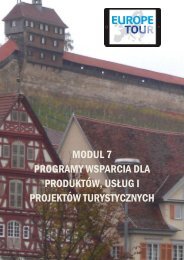Module_7_Funding
Create successful ePaper yourself
Turn your PDF publications into a flip-book with our unique Google optimized e-Paper software.
CULTURAL TOURISM TRAINING COURSE<br />
MODULE 7 - FUNDING OF TOURISM PRODUCTS, SERVICES<br />
AND PROJECTS<br />
MODULE 7<br />
FUNDING OF TOURISM<br />
PRODUCTS, SERVICES AND<br />
PROJECTS<br />
1
CULTURAL TOURISM TRAINING COURSE<br />
MODULE 7 - FUNDING OF TOURISM PRODUCTS, SERVICES<br />
AND PROJECTS<br />
This Training <strong>Module</strong> is part of the Cultural Tourism Training Course which has been developed within<br />
the Erasmus+ Strategic Partnership EUROPETOUR, a European initiative aimed at unlocking the economic<br />
potential of Europe’s outstanding cultural treasures and empowering rural areas to harvest the<br />
potential of cultural tourism.<br />
You can find more information at the homepage: http://www.europetour.tips<br />
Pictures: Wolfgang Eisenreich, Kees Grootswagers, Elena Paschinger, INI-Novation Bulgaria<br />
The EUROPETOUR team would like to express their sincere gratitude to Mrs Jenifer Hawks of Future<br />
for Religious Heritage (Brussels) for proof reading the EUROPTOUR training modules and Social Media<br />
Guidelines.<br />
This work is licensed under a Creative Commons Attribution-NonCommercial-ShareAlike 4.0 International<br />
License.<br />
You are free to:<br />
share — copy and redistribute the material in any medium or format<br />
adapt — remix, transform, and build upon the material<br />
under the following terms:<br />
Attribution — You must give appropriate credit, provide a link to the license, and indicate if<br />
changes were made. You may do so in any reasonable manner, but not in any way that<br />
suggests the licensor endorses you or your use.<br />
NonCommercial — You may not use the material for commercial purposes.<br />
ShareAlike — If you remix, transform, or build upon the material, you must distribute your<br />
contributions under the same license as the original.<br />
The European Commission support for the production of this publication does not constitute an endorsement of the contents which<br />
reflects the views only of the authors, and the Commission cannot be held responsible for any use which may be made of the information<br />
contained therein.<br />
Project number: 2015-1-DE02-KA202-002325<br />
2
CULTURAL TOURISM TRAINING COURSE<br />
MODULE 7 - FUNDING OF TOURISM PRODUCTS, SERVICES<br />
AND PROJECTS<br />
Table of contents<br />
Contents of the <strong>Module</strong> .......................................................................................................................... 4<br />
Objectives ................................................................................................................................................ 4<br />
Overview on financing instruments ........................................................................................................ 7<br />
Internal funding ..................................................................................................................................... 10<br />
What are internal sources of finance? .................................................................................................. 10<br />
Advantages of internal funding ............................................................................................................. 11<br />
External financing schemes ................................................................................................................... 14<br />
Financing the development of existing cultural tourism companies .................................................... 15<br />
Financing through European funds ....................................................................................................... 20<br />
European Fund for Strategic Investments ............................................................................................. 21<br />
European Regional Development Fund ................................................................................................. 22<br />
Cohesion Fund ....................................................................................................................................... 24<br />
European Agriculture Fund For Rural Development ............................................................................. 25<br />
Participation in European Programmes ................................................................................................ 27<br />
LIFE ........................................................................................................................................................ 28<br />
COSME ................................................................................................................................................... 30<br />
Creative Europe Programme ................................................................................................................. 32<br />
Erasmus+ ............................................................................................................................................... 34<br />
Employment and Social Innovation (EaSI)............................................................................................ 36<br />
Best Practice .......................................................................................................................................... 38<br />
39<br />
3
CULTURAL TOURISM TRAINING COURSE<br />
MODULE 7 - FUNDING OF TOURISM PRODUCTS, SERVICES<br />
AND PROJECTS<br />
Contents of the <strong>Module</strong><br />
This chapter will inform you about the various financing systems that are needed to secure the<br />
financial viability of your cultural touristic enterprise.<br />
Unit 1 Overview on financing instruments<br />
Unit 2 Internal funding<br />
Unit 3 External financing schemes<br />
Unit 4 Financing through European Funds<br />
Unit 5 Participation in European Programmes<br />
Unit 6 National funding programmes for cultural tourism<br />
Objectives<br />
So far you have learned that your cultural touristic activities always have an entrepreneurial dimension<br />
with several business aspects. One of the most important questions regarding the establishment of a<br />
business venture is the financing of the preparation and implementation phases. Results need to be<br />
developed for the tourism market, the entrepreneurial concept has to be defined, resources have to be<br />
structured, and the first steps towards business operations have to be taken. Several different<br />
advancement models and financing sources for such steps exist for the so-called Pre-Seed, Seed and<br />
the Start-up phases of entrepreneurial cultural tourism concepts. This module will introduce some of<br />
the relevant financing schemes and the unique features of the financing possibilities being available.<br />
Before planning, implementing and operating your cultural tourism concept, alternatives for the<br />
successful financing of business operations have to be considered. Each individual financing option has<br />
to be discussed and consequently the various alternative actions an entrepreneur may take have to be<br />
addressed. Therefore, cultural tourism entrepreneurs need an overview on the different forms of<br />
financing, but also obtain on their own more detailed insights into the motivations and perspectives of<br />
potential capital providers. Consequently, this module has several objectives:<br />
Firstly, we want to give an overview on the various financing schemes which are available. You will see<br />
that there are much more possibilities than conventional loans.<br />
Secondly, we have compiled an overview of most important financing mechanisms in the countries of<br />
the partnership. You will find them in the various language versions.<br />
Thirdly, we want to raise the awareness of the reader to the existence of European funding. We will<br />
summarize in an easily understandable and accessible form the various sources of funding that are<br />
4
CULTURAL TOURISM TRAINING COURSE<br />
MODULE 7 - FUNDING OF TOURISM PRODUCTS, SERVICES<br />
AND PROJECTS<br />
available in the European Union: and we will show that there are not only financing schemes available,<br />
but also various programmes in which tourism businesses can participate and receive funding. After<br />
exploring the “funding jungle”, we have selected the eight most imporant European Funds and<br />
Programmes that seem to be “exploitable” for cultural tourism in the rural area.<br />
5
CULTURAL TOURISM TRAINING COURSE<br />
MODULE 7 - FUNDING OF TOURISM PRODUCTS, SERVICES<br />
AND PROJECTS<br />
Unit 1<br />
Overview on financing<br />
instruments<br />
6
CULTURAL TOURISM TRAINING COURSE<br />
MODULE 7 - FUNDING OF TOURISM PRODUCTS, SERVICES<br />
AND PROJECTS<br />
Overview on financing instruments<br />
Ramping up a cultural tourism business needs funding, which can thus be from its own resources or it<br />
can be sourced from somewhere else. When a company sources the funding from its own sources i.e.<br />
from its own assets, from its own profits, we would call it an internal source of financing. When a<br />
company needs huge money and only internal sources are not enough, they go out and take loans<br />
from banks or other financial institutions. The following chart provides an overview on the different<br />
funding schemes in general:<br />
If we do a quick comparison, we will realise that there are key differences between internal financing<br />
and external financing:<br />
<br />
<br />
<br />
<br />
Internal sources of finance are sources inside the business. External sources of finance, on the<br />
other hand, are sources outside the business.<br />
Companies look for funding internally when the fund requirement is quite low. In the case,<br />
external sources of financing the fund requirement are usually quite huge.<br />
When a company sources the funding internally, the cost of capital is pretty low. In the case<br />
of external sources of financing, the cost of capital is medium to high.<br />
Internal sources of funding don’t require any collateral. But external sources of funding require<br />
collateral (or transfer of ownership).<br />
Popular examples of internal and external sources of financing are illustrated below.<br />
Internal and external sources of financing are both important, but the entrepreneur should know where<br />
to use what. And the entrepreneur should know, when to use what; or to be more specific: the<br />
7
CULTURAL TOURISM TRAINING COURSE<br />
MODULE 7 - FUNDING OF TOURISM PRODUCTS, SERVICES<br />
AND PROJECTS<br />
entrepreneur should be aware of the fact that not at every time of the life-cycle of the entrepreneurial<br />
concept all financing sources and funding schemes are properly available.<br />
The „j-curve of entrepreneurial financing“ (which is in literature often also refrred to as „hockey-stick<br />
curve“ describes the different phases of financing a business from starting it up to wards growing and<br />
sustainable operation. Each of these phases require a primary focus and the different financing sources<br />
and poses specific challenges accordingly.<br />
As the chart above shows, the J-curve is used to illustrate the tendency of entrepreneurial financing to<br />
deliver negative returns in early years and investment gains in the outlying years. The chart also shows<br />
that in each and every of this growth path there are only specific funding instruments available as the<br />
business grows. In the early years, a number of factors contribute to negative returns including<br />
boostrapping costs, marketing costs, salaries, management effort, basic equipoment costs etc. Over<br />
time the operations will begin to experience unrealized gains followed eventually by events in which<br />
gains are realized and an expansion of the business can be accomplished by so-called „organic<br />
growth“, which means mainly out of own revenues and other internal funding schemes as laid out in<br />
the next chapter.<br />
8
CULTURAL TOURISM TRAINING COURSE<br />
MODULE 7 - FUNDING OF TOURISM PRODUCTS, SERVICES<br />
AND PROJECTS<br />
Unit 2<br />
Internal funding<br />
9
CULTURAL TOURISM TRAINING COURSE<br />
MODULE 7 - FUNDING OF TOURISM PRODUCTS, SERVICES<br />
AND PROJECTS<br />
Preliminary Note<br />
In the previous modules you have learned how to professionalise yourself in cultural tourism in order<br />
to generate income. You have familiarized yourself with the most important instruments and methods<br />
you need to do this. This is the sustainable way to make your cultural tourism enterprise fit for the<br />
future.<br />
In this module you will learn a lot about financing instruments which are not easy to get and which<br />
are not necessarily sustainable. These instruments are at best a supplement to your entrepreneurial<br />
commitment for boosting developments. They will never be at the centre of your business if you want<br />
to organise your company sustainably. At first glance some of the instruments presented below might<br />
seem very far from your working reality as a cultural tourism enterprise. Believe us: It is not! If you<br />
want to position yourself professionally in the cultural tourism market, sooner or later you will have to<br />
deal with it, because this will become or is already part of your entrepreneurial strategy.<br />
But don't be fooled by the wealth of possible financing instruments: These are tools for the development<br />
of your enterprise, not an end in itself. Your first objective as a cultural tourism entrepreneur will<br />
therefore always be to generate direct income from your business activities.<br />
Internal funding<br />
In order to grow your cultural touristic business, it is important to invest in it. This means that you<br />
need access to finance. Unfortunately, external sources of finance — sponsors, donators, lenders or<br />
investors — are often sceptical, especially in the case of smaller businesses. This can leave you to rely<br />
on internal sources of finance for investing in your business.<br />
What are internal sources of finance?<br />
Retained earnings<br />
Retained earnings are an easy source of internal financing to use because they are liquid assets.<br />
Retained earnings are the portion of net income that you have retained in your business and not paid<br />
out. In a small business, retained earnings are usually paid out to the owners, who often do not draw<br />
a budgeted salary. Instead of paying out retained earnings, you can reinvest them into your cultural<br />
tourism project.<br />
Current assets<br />
Current assets consist of cash or anything that can easily be converted into cash. For example, if your<br />
business has stock holdings in other companies, you can sell them and use the income as a source of<br />
financing. You should be careful, however, not to decrease your current assets to levels less than your<br />
current liabilities, as this may prevent you from paying off your debts.<br />
10
CULTURAL TOURISM TRAINING COURSE<br />
MODULE 7 - FUNDING OF TOURISM PRODUCTS, SERVICES<br />
AND PROJECTS<br />
Fixed assets<br />
Fixed assets are those that are not easily converted to cash. Typically, these assets include equipment,<br />
property and factories. Because these assets take time to convert to cash, they cannot be relied on<br />
for short-term access to finance. If you have the time, however, you could, e.g., sell off some equipment<br />
or even property to invest in your business.<br />
Personal savings<br />
Personal savings are the backbone of many small tourism businesses. If your business doesn't have the<br />
assets to finance your project, you may still have personal finances that you can contribute to the<br />
business. This provides an alternative to seeking external donators or loans and allows you to retain<br />
control over your business.<br />
Free resources<br />
Have you ever thought about the free resources which are avalable for you? They can be taken as<br />
internal financing as well although they might not look as financing at first sight. Voluntary<br />
contributions by supporters, networks and free information on any relevant matter might be that kind<br />
of resources. E.g. the chambers of commerce offer numerous free support measures which are<br />
resources you have free access to – just grab it!<br />
Advantages of internal funding<br />
Internal funding vs. bank financing<br />
When you use company funds, you do not have to pay interest to the bank. You also do not have to<br />
go through the application process, which can be costly if you have to pay someone to prepare profit<br />
and loss statements, balance sheets and other documentation required by the bank.<br />
Internal funding vs. selling stock<br />
One way to raise money for your business projects is to sell stock to investors. This gives them part<br />
ownership of your business. Using internal funding offers the advantage of keeping control in the hands<br />
of the company's founders.<br />
Internal funding vs. government grants<br />
Especially in the tourism sector, your business may qualify for government grants under certain<br />
circumstances. However, the application process can be lengthy and expensive. The expense comes<br />
from preparing the documentation for these grants. You have to win the approval of the agency giving<br />
the grant, and this can involve many individuals and committees. With internal funding, you can start<br />
on your project immediately, with no approval required other than that of your management.<br />
11
CULTURAL TOURISM TRAINING COURSE<br />
MODULE 7 - FUNDING OF TOURISM PRODUCTS, SERVICES<br />
AND PROJECTS<br />
Internal funding vs. selling assets<br />
Some businesses try to fund new expenditures by selling assets. This decreases the value of the<br />
company and can trigger transaction costs, as well as taxes. Internal funding keeps all assets in the<br />
company and incurs no additional expenses beyond the cost of the project itself.<br />
12
CULTURAL TOURISM TRAINING COURSE<br />
MODULE 7 - FUNDING OF TOURISM PRODUCTS, SERVICES<br />
AND PROJECTS<br />
Unit 3<br />
External financing<br />
schemes<br />
13
CULTURAL TOURISM TRAINING COURSE<br />
MODULE 7 - FUNDING OF TOURISM PRODUCTS, SERVICES<br />
AND PROJECTS<br />
External financing schemes<br />
Facing the need for a financing situation?<br />
Your access to finance depends on how attractive your cultural tourism business looks to donators<br />
and financial institutions. Your capacity to plan and manage your financing needs and to develop a<br />
robust business proposal is a crucial issue; and this includes also knowledge of available financing<br />
options. Strategic business planning is essential to put in place the structures in order to respond to<br />
the financing needs of your business and to assure the viability of your business in an increasingly<br />
complex tourism environment.<br />
All businesses need access to sufficient financing to grow. Even where you may not wish to invest,<br />
expand and grow your business, your cultural tourism enterprise will still need financing to support<br />
your day-to-day operation and to maintain your market position.<br />
We must also take into consideration that many small cultural tourism enterprises, especially in rural<br />
areas, are managed by people who do not have an academic degree in business administration. The<br />
business of these “lifestyle entrepreneurs”, often young people, or people with a migrant background,<br />
or people working on a co-operative model, faces bigger challenges in accessing external financing.<br />
Their business proposals may not be well-founded or commercially robust. Banks are increasingly more<br />
reluctant to finance these entrepreneurs and other newcomers, but also their understanding of the<br />
tourism business may be limited and their financial management knowledge and skills may need<br />
support.<br />
Collateral requirements of the banks for providing a loan have also an impact on the ability of cultural<br />
tourism businesses. This may become a major obstacle especially if you are a service provider with no<br />
or only few fixed or tangible assets. Banks generally look at real-estate based collateral when they<br />
assess your financing application, rather than your cash flow and your profit generating capability. Your<br />
service-based tourism business will usually face difficulties in assessing the market-value of your<br />
intangibles which will not be accepted as collateral. This means that your business will be significantly<br />
under-evaluated. The banks’ focus on real-estate based collateral is also a challenge if your property is<br />
already pledged to secure a loan.<br />
14
CULTURAL TOURISM TRAINING COURSE<br />
MODULE 7 - FUNDING OF TOURISM PRODUCTS, SERVICES<br />
AND PROJECTS<br />
Financing innovation and new cultural tourism enterprises<br />
At the early stages of an idea or a product development process, your business is not yet economically<br />
viable or profitable. You are in a loss zone. Apart from your own capital, this phase is<br />
usually financed with funds from friends and family who decide, based on private information, whether<br />
or not to invest in your idea or project.<br />
Public support will usually consist of different implementation subsidies, including interest rate subsidies,<br />
grants, or tax incentives. Please refer to Unit 2 which will list some of the national or regional subsidies<br />
that you might use. In Unit 3 and 4, you will find an overview on European Funds and European<br />
Programmes with <strong>Funding</strong>.<br />
Finance instruments available for cultural tourism start ups<br />
Private support<br />
Private money (friends and family)<br />
Business angels<br />
Crowdfunding<br />
Public support<br />
Interest rate subsidies<br />
Grants<br />
Tax incentives<br />
Financing the development of existing cultural tourism organisations<br />
During the development stages of your cultural tourism business, it will gradually become economically<br />
viable. You will be able to access a larger variety of financing resources:<br />
credit loans<br />
crowdfunding opportunities<br />
venture capital firms<br />
private equity<br />
which will help you to finance your day-to-day needs, or renovation and expansion activities.<br />
If you are in a small business, then you will probably rely largely on internal and informal sources of<br />
financing, such as personal loans, overdraft facilities, credit card use, savings and working capital, when<br />
you have to fund your day-to-day operations.<br />
Retained earnings are difficult to build up for small tourism enterprises as most earnings are<br />
immediately reinvested.<br />
15
CULTURAL TOURISM TRAINING COURSE<br />
MODULE 7 - FUNDING OF TOURISM PRODUCTS, SERVICES<br />
AND PROJECTS<br />
Finance instruments available for established cultural tourism companies and entrepreneurs<br />
Private support<br />
Standard bank loans<br />
Asset-based finance<br />
Private equity and venture capital<br />
Crowdfunding<br />
Mezzanine finance<br />
Public support<br />
Loan guarantees<br />
Short-term bank loans are well suited for financing your marketing activities, new software and technologies,<br />
or for refreshing your products. Medium- and long-term bank loans are more appropriate for<br />
larger investment projects, including renovating or developing new facilities. Overdraft facilities are an<br />
important but expensive tool used by seasonal businesses to manage cash flow, particularly at the<br />
start of the season.<br />
In any case, if you plan your cultural torusim business and have the business plan ready for external<br />
review, then it is highly recommend to discuss a financing opportunity with bank representavies. The<br />
purpose is not necessarily to receive a bank loan; moreover the banks offer a diverse set of start-up<br />
support, which may range from management support and consulting, to information flow to assess your<br />
concept without charges, to accessing local, regional nrtworks up towards organisation of and<br />
participation in fairs.<br />
If you have to rely on certain assets for your business operations (e.g. bicycles for excursion tours, or<br />
kitchen furniture if you are in the food services), you can borrow using the modality of asset-based<br />
finance. The rationale is similar: the asset is used as collateral for the loan. However, asset-based<br />
finance is not suitable for tourism producing only service-based intangibles.<br />
Mezzanine financing is a hybrid of debt and equity financing that gives the lender the rights to convert<br />
to an ownership or equity interest in your business in case of default, after venture capital companies<br />
and other senior lenders are paid. Mezzanine financing is usually completed with a less strict evaluation<br />
process on the part of the lender and little or no collateral on the part of the borrower, is<br />
treated like equity on a company's balance sheet.<br />
16
CULTURAL TOURISM TRAINING COURSE<br />
MODULE 7 - FUNDING OF TOURISM PRODUCTS, SERVICES<br />
AND PROJECTS<br />
New financing approaches with greater participation of the private sector<br />
While bank financing will continue to be crucial for most of the (cultural) tourism sector, in the last<br />
years a more diversified set of financing options has emerged which can help you to strengthen your<br />
capital structures and decrease your dependency on borrowing.<br />
This chapter will focus your attention on the development of non-bank financing instruments such as<br />
asset-based finance and alternative debt systems.<br />
Asset‐based finance<br />
Asset-based finance comprise leasing, asset-based lending, factoring, and purchase order finance.<br />
Asset-based lending is any kind of lending secured by an asset. This means, if the loan is not repaid,<br />
the asset is taken. In this sense, a mortgage is an example of an asset-based loan. More commonly<br />
however, the phrase is used to describe lending to business and large corporations using assets not<br />
normally used in other loans. Typically, these loans are tied to inventory, accounts receivable, machinery<br />
and equipment.<br />
Factoring is a financial transaction in which a business sells its accounts receivable (i.e. invoices) to a<br />
third party (called a factor) at a discount.<br />
Purchase order financing is a funding option if your business needs cash to fill customer orders.<br />
Especially in tourism, periodical cash flow problems exist. There will be times where there is simply not<br />
enough money available to cover the costs of doing your business. As a result, there may be an order<br />
from a client that you are not able to fulfil due to a lack of cash. Having to turn the order down<br />
would not only mean loss of revenue, but also a loss of your reputation. If word gets around that you<br />
are turning away business because you can’t afford to complete your job, customer trust will be<br />
diminished.<br />
Alternative financing<br />
Alternative debt mechanisms (e.g. crowdfunding, securitised debts, corporate or covered bonds) hold<br />
potential for your cultural tourism business. However, very often these innovative and alternative<br />
financing methods remain underdeveloped due in part to bureaucratic and regulatory constraints, but<br />
also because of a lack of knowledge and understanding.<br />
The two most interesting mechanisms are peer-to-peer lending and equity crowd-funding. They are<br />
innovative financing approaches that can provide your business a simple, low-cost way to raise capital<br />
from public investors. These internet-based models provide an alternative source of financing for you,<br />
especially if you do not readily have access to financing through traditional means.<br />
17
CULTURAL TOURISM TRAINING COURSE<br />
MODULE 7 - FUNDING OF TOURISM PRODUCTS, SERVICES<br />
AND PROJECTS<br />
Peer-to-peer lending (also known as crowd-lending) is a form of debt crowdfunding. It matches people<br />
who want loans with people who are potentially willing to fund those loans. The matching is completed<br />
via an intermediary – a peer-to-peer lending service, typically provided online. Borrowers list the details<br />
of their request (the amount sought and the intended use) on a peer-to-peer lending website. Lenders<br />
browse the website to decide which loans to invest in.<br />
Equity crowdfunding provides a means for investors from the "crowd" (or investing public) to invest in a<br />
project or firm in exchange for shares. You can offer "perks" or rewards (such as free holiday nights or<br />
discounts) in exchange for investment. You stipulate the amount you wish to raise from investors. Once<br />
this funding is utilised, any surplus (minus fees) becomes available to your firm for its use.<br />
Crowdfunding is usually facilitated via an online equity crowdfunding intermediary and is most commonly<br />
used by newer firms at the earlier stages of their development. Legislative changes are opening<br />
up opportunities for projects to raise funds from many investors, each contributing small amounts of<br />
financing, while diminishing transaction costs as these investments are made online and through bank<br />
transfers. Another advantage of these finance techniques is that they enable the borrower to gather<br />
funds in a shorter time span than bank loans.<br />
Although not yet much used in tourism, these models offer considerable potential as a source of<br />
capital for your cultural tourism business. This innovative finance technique creates a network of<br />
investors and spreads the financial risk. At the same time, these approaches are also serving the<br />
double purpose of providing finance and supporting local development: people invest in projects they<br />
care about and help local firms to create jobs.<br />
18
CULTURAL TOURISM TRAINING COURSE<br />
MODULE 7 - FUNDING OF TOURISM PRODUCTS, SERVICES<br />
AND PROJECTS<br />
Unit 4<br />
Financing through<br />
European funds<br />
19
CULTURAL TOURISM TRAINING COURSE<br />
MODULE 7 - FUNDING OF TOURISM PRODUCTS, SERVICES<br />
AND PROJECTS<br />
Financing through European funds<br />
Overview<br />
The objective of this and the following unit is to summarize in an easily understandable and accessible<br />
form the various sources of funding that are available in the European Union. After exploring the<br />
“funding jungle”, we have identified eight European Funds and Programmes that seem so be “exploitable”<br />
for cultural tourism in the rural area: They are described in the Units 4 and 5 as follows:<br />
Unit 4 lists European Funds that offer financing schemes. They are approaches usually through national<br />
contact points and/or through national banks<br />
European Fund for Strategic Investments<br />
European Regional Development Fund<br />
Cohesion Fund<br />
European Agriculture Fund For Rural Development<br />
Unit 5 lists some European Programmes that offer funding for organisations through participation in<br />
their project activities. Here, you must decide whether the priority of the programme coincides with<br />
your funding requirements<br />
LIFE<br />
COSME<br />
Creative Europe Programme<br />
Employment And Social Innovation<br />
The various funds and programmes reflect the diversity of the tourism sector's needs; and the range of<br />
EU thematic programmes that can consequently support it. The tourism sector gets support from<br />
various programmes, but gathering and digesting information about many programmes remains a<br />
challenge for hard-pressed private and public entities. We hope that this <strong>Module</strong> will make the overview<br />
easier. It focuses on the most important EU programmes for the tourism sector, around practical<br />
questions: type of tourism-related actions eligible for funding; who can apply; type and level of funding;<br />
and how to apply & when.<br />
The period of funds and programmes covers the years 2014 to 2020. Consequently, the information<br />
contained in this <strong>Module</strong> will also be accurate only for this period. More precisely, the compilation took<br />
place in 2016/17 and we suggest readers to refer to the respective websites to obtain the most<br />
recent information.<br />
Conceived as an entry point to specialised websites, this <strong>Module</strong> contains many internet links. Some of<br />
these links are fairly long and cryptic. Most of them have therefore been inserted as hyperlinks.<br />
For brevity sake, the <strong>Module</strong> only covers what is indispensable to know for getting support. Therefore,<br />
it does not cover the following elements: references to the various acts underpinning a programme,<br />
starting with its financial regulation; its general governance; its actions targeting other sectors; its<br />
overall budget; changes in the budgetary allocation between programmes; etc. This generic information<br />
can be found through the hyperlinks.<br />
20
CULTURAL TOURISM TRAINING COURSE<br />
MODULE 7 - FUNDING OF TOURISM PRODUCTS, SERVICES<br />
AND PROJECTS<br />
European Fund for Strategic Investments<br />
The European Fund for Strategic Investments (EFSI) is an initiative to help overcome the current investment<br />
gap in the EU by mobilising private financing for strategic investments. EFSI may support,<br />
among other things:<br />
1. Strategic infrastructure including digital, transport and energy<br />
2. Education, research, development and innovation<br />
3. Expansion of renewable energy and resource efficiency<br />
4. Support for smaller businesses<br />
Type of tourism‐related actions eligible for funding<br />
Any type of useful transaction or investment for the development of legitimate (SMEs) activities. Everywhere<br />
in the EU, including cross-border projects (no geographic quotas). Such activities may for instance<br />
focus on:<br />
Travel infrastructures (regional airports, ports, …)<br />
Energy efficiency of hotels and tourism resorts<br />
Revitalisation of former industrial areas for recreational purposes<br />
Who can apply within the tourism sector?<br />
All legal persons (any public body, company and in particular SMEs, research organisations, universities,<br />
non-governmental organisations, tourism clusters ...) via financial intermediaries.<br />
How to apply and when<br />
For loans or bank guarantees, apply to the financial intermediaries (e.g. commercial banks) supported<br />
by EFSI. Access to finance: http://europa.eu/youreurope/business/funding-grants/access-to-finance/<br />
21
CULTURAL TOURISM TRAINING COURSE<br />
MODULE 7 - FUNDING OF TOURISM PRODUCTS, SERVICES<br />
AND PROJECTS<br />
European Regional Development Fund<br />
The European Regional Development Fund (ERDF) is one of the five "European Structural and Investment<br />
Funds" The ERDF aims to strengthen economic and social cohesion in the European Union by<br />
correcting imbalances between its regions. It may provide essential support to improve the competitiveness<br />
and quality of tourism at regional and local levels, notably in areas in (industrial / rural) decline<br />
or those undergoing urban regeneration.<br />
ERDF support has 11 "thematic objectives and investment priorities" in line with the Europe 2020 policy<br />
priorities. The most relevant for the tourism sector probably are:<br />
Research and innovation<br />
Information and Communication Technologies<br />
Competitiveness of Small and Medium-Sized Enterprises<br />
Environmental protection and resource efficiency<br />
Education, skills and lifelong learning<br />
Type of tourism‐related actions eligible for funding<br />
These programmes may for instance support:<br />
the development of tourism-related ICT products (apps, data mining, …)<br />
the development of innovative tourism services, in particular in less favoured and peripheral<br />
regions with underdeveloped industrial structures and strongly dependent on tourism (new<br />
business models, exploitation of new ideas, …)<br />
the development of high value added products and services in niche markets (health tourism,<br />
tourism for seniors, cultural and ecotourism, gastronomy tourism, sports tourism, etc.) by mobilising<br />
specific local resources and therefore contributing to smart regional specialisation<br />
clustering activities among different tourism industries as well as with creative industries, to diversify<br />
regional tourism products and extend the tourism season<br />
the protection, promotion and development of natural and cultural tourism assets and related<br />
services<br />
small-scale cultural and sustainable tourism infrastructure<br />
measures in favour of entrepreneurship, self-employment and business creation as well as the<br />
internationalisation of tourism SMEs and clusters<br />
vocational training, skills upgrading<br />
22
CULTURAL TOURISM TRAINING COURSE<br />
MODULE 7 - FUNDING OF TOURISM PRODUCTS, SERVICES<br />
AND PROJECTS<br />
Who can apply within the tourism sector?<br />
All legal persons (any public body, company and in particular SMEs, research organisations, universities,<br />
non-governmental organisations, tourism clusters ...)<br />
How to apply and when<br />
Start by checking the ERDF Programmes available in your region and verify that your project meets the<br />
selection criteria and investment priorities. Follow the application procedures of the relevant managing<br />
authority. For loans or bank guarantees, apply to the financial intermediaries.<br />
More information: http://ec.europa.eu/regional_policy/en/funding/erdf/<br />
23
CULTURAL TOURISM TRAINING COURSE<br />
MODULE 7 - FUNDING OF TOURISM PRODUCTS, SERVICES<br />
AND PROJECTS<br />
Cohesion Fund<br />
The Cohesion Fund (CF) is one of the five "European Structural and Investment Funds". In order to<br />
reduce economic and social disparities and to promote sustainable development, the Cohesion Fund is<br />
aimed at Member States whose Gross National Income (GNI) per inhabitant is less than 90 % of the<br />
EU average.<br />
Type of tourism‐related actions eligible for funding<br />
Depends on the needs of each Member State, as defined in their Operational Programmes.<br />
Who can apply within the tourism sector?<br />
All legal persons (any public body, company and in particular SMEs, research organisations, universities,<br />
non-governmental organisations, tourism clusters ...)<br />
More information: http://ec.europa.eu/regional_policy/en/funding/cohesion-fund/<br />
Type and level of funding<br />
Grants. Level of funding defined in the calls prepared by Managing Authorities. Maximum co-financing<br />
rate of 85 %.<br />
24
CULTURAL TOURISM TRAINING COURSE<br />
MODULE 7 - FUNDING OF TOURISM PRODUCTS, SERVICES<br />
AND PROJECTS<br />
European Agriculture Fund For Rural Development<br />
The "European Agriculture Fund for Rural Development" (EAFRD) aims, among other things, at promoting<br />
economic development in rural areas. Depending on the needs and choices of each Member State,<br />
support may be granted to:<br />
the development of non-agricultural SMEs in rural areas and engaged in sustainable & responsible<br />
tourism<br />
the restoration / upgrading of the cultural and natural heritage of villages and rural landscapes.<br />
Type of tourism‐related actions eligible for funding<br />
Eligible actions are listed in the national and regional "Rural Development Programmes". They may<br />
fund:<br />
vocational training and skills acquisition actions (courses, workshops, coaching … for instance<br />
on how to develop rural tourism), demonstration activities and information actions<br />
business start-up aid as well as investments for non-agricultural activities in rural areas (rural<br />
accommodation, shops, restaurants, guided tours, …)<br />
drawing up and updating of plans for the development of municipalities and villages in rural<br />
areas<br />
investments for public use in recreational infrastructure, tourist information and small scale<br />
tourism infrastructure<br />
studies and investments associated with the maintenance, restoration and upgrading of the cultural<br />
and natural heritage of villages<br />
co-operation involving at least two entities (creation of clusters and networks; co-operation<br />
among small operators for the development and/or marketing of tourism services relating to<br />
rural tourism; …)<br />
Who can apply within the tourism sector?<br />
Any natural or legal person active in rural areas (farmer, forestry company, SMEs operating in rural<br />
areas …). The managing authorities for this Fund are listed on the websites of the Ministry for Agriculture<br />
in your country.<br />
Type and level of funding<br />
The EAFRD is providing grants, with a minimum contribution rate of 20 %. For co-operation actions,<br />
support is limited to maximum 7 years.<br />
25
CULTURAL TOURISM TRAINING COURSE<br />
MODULE 7 - FUNDING OF TOURISM PRODUCTS, SERVICES<br />
AND PROJECTS<br />
Unit 5<br />
Participation in<br />
European Programmes<br />
26
CULTURAL TOURISM TRAINING COURSE<br />
MODULE 7 - FUNDING OF TOURISM PRODUCTS, SERVICES<br />
AND PROJECTS<br />
Participation in European Programmes<br />
Overview<br />
The objective of this unit is to list some European Programmes that offer funding for organisations<br />
through participation in their project activities. Usually, these Programmes do not offer funding for<br />
investments, but rather for staff training or the elaboration of products such as training concepts etc.<br />
E.g., the development of this marketing course has been funded by the Erasmus+ Programme, and the<br />
organisations who participated in this project benefitted through substantial funding of their staff costs.<br />
However, in these programmes you must decide whether the priority of the programme coincides with<br />
your funding requirements.<br />
In this unit, we present an overview about the following programmes:<br />
LIFE<br />
COSME<br />
Creative Europe Programme<br />
Employment And Social Innovation<br />
The period of these programmes covers the years 2014 to 2020. Consequently, the information of<br />
contained in this <strong>Module</strong> will also be accurate only for this period. However, since most of these<br />
programmes issue yearly prorities, we suggest to consult the latest calls to obtain the most recent<br />
information.<br />
27
CULTURAL TOURISM TRAINING COURSE<br />
MODULE 7 - FUNDING OF TOURISM PRODUCTS, SERVICES<br />
AND PROJECTS<br />
LIFE<br />
LIFE is the financial instrument supporting environmental and nature conservation projects throughout<br />
the EU. The priority areas of its sub-programme for environment are:<br />
<br />
<br />
<br />
Environment and Resource Efficiency<br />
Nature and Biodiversity<br />
Environmental Governance and Information<br />
Type of tourism‐related actions eligible for funding<br />
The most relevant actions are probably those envisaged under the so-called "Traditional Projects",<br />
which may take different forms:<br />
<br />
<br />
<br />
<br />
pilot projects assess the effectiveness of a method/approach that is new or has been used in<br />
a different (geographical, ecological, socio-economic) context; they compare its results with<br />
those produced by best practices, in order to determine if the method should be tested on a<br />
larger scale (i.e. in a demonstration project) and inform stakeholders;<br />
demonstration projects test and evaluate a method/approach that is new or has been used in<br />
a different context; they inform other stakeholders of the results and, where appropriate,<br />
encourage them to apply these methods / approaches;<br />
best practice projects apply appropriate, cost-effective and state-of-the-art techniques, methods<br />
and approaches taking into account the specific context of the project<br />
information, awareness and dissemination projects related to one of the priority areas.<br />
If LIFE does not finance big infrastructure projects, it may support investment in "Green Infrastructure"<br />
through grants and loans/bank guarantees.<br />
Who can apply within the tourism sector?<br />
All legal entities (SMEs, NGOs, public authorities, …)<br />
Type and level of funding<br />
Grants for "traditional projects". € 500.000 to 1,5 million, with a maximum co-funding rate of 60 %,<br />
except for projects targeting priority habitats & species (75 %).<br />
28
CULTURAL TOURISM TRAINING COURSE<br />
MODULE 7 - FUNDING OF TOURISM PRODUCTS, SERVICES<br />
AND PROJECTS<br />
How to apply and when<br />
For Grants, go to the funding page of the LIFE programme. Except for "traditional" projects, applicants<br />
must use the application form provided in LIFE application packages (available on the same page) and<br />
submit them to the "Executive Agency for Small and Medium-sized Enterprises" (EASME). Proposals for<br />
"traditional" projects must be created and submitted via the eProposal tool. When preparing the<br />
proposal, applicants may consult the relevant LIFE National Contact Point in the Member States.<br />
For loans or bank guarantees, apply to the financial intermediaries.<br />
More information: http://ec.europa.eu/environment/life/funding/life2014/index.htm<br />
29
CULTURAL TOURISM TRAINING COURSE<br />
MODULE 7 - FUNDING OF TOURISM PRODUCTS, SERVICES<br />
AND PROJECTS<br />
COSME<br />
COSME is the EU programme for the Competitiveness of Enterprises and Small and Medium-sized<br />
Enterprises (SMEs). It supports SMEs in four areas:<br />
<br />
<br />
<br />
<br />
facilitate access to finance for SMEs through the "Loan Guarantee Facility"and the "Equity<br />
Facility for Growth"<br />
improving access to markets (notably thanks to the services provided by the Enterprise Europe<br />
Network)<br />
improving framework conditions for the competitiveness and sustainability of Union enterprises,<br />
notably thanks to the Tourism Action Plan<br />
promoting entrepreneurship and entrepreneurial culture, notably thanks to the “Erasmus for<br />
young entrepreneurs” exchange scheme<br />
COSME offers an own tourism targeted funding scheme which is most intersting in the context of<br />
cultural tourism in rural areas.<br />
Type of tourism‐related actions eligible for funding<br />
TOURISM ACTION PLAN<br />
Some of the Tourism Action Plan's objectives are pursued through calls for proposals and calls for<br />
tenders open to the tourism sector. These may concern, among other things:<br />
<br />
<br />
<br />
<br />
the development and/or promotion of sustainable transnational thematic tourism products<br />
(linked, for instance, European routes dedicated to specific aspects of our cultural and industrial<br />
heritage, cycling trails, eco-tourism, maritime and sub-aquatic areas, etc.).<br />
the development and/or promotion of niche products exploiting synergies between tourism and<br />
creative industries at European level (e.g. European Route around high-end products)<br />
transnational public and private partnerships developing tourism products targeting specific age<br />
groups (e.g. seniors and youth) to increase tourism flows between European countries during<br />
the low and medium seasons<br />
capacity building schemes for "accessible tourism" (i.e. to all, regardless of their physical<br />
limitations, disabilities or age) whereby destination managers, entrepreneurs, …, can learn from<br />
experienced and successful 'accessible' operators, create synergies with other operators along<br />
the supply chain, explore new market opportunities and way to make business.<br />
ERASMUS FOR YOUNG ENTREPRENEURS<br />
This exchange scheme allows young entrepreneurs to spend 1 to 6 months with an experienced<br />
entrepreneur based in another European country and ready to act as a mentor. Young entrepreneurs<br />
and their hosts get to discover new European markets or business partners, different ways of doing<br />
business, and possibly decide to continue their collaboration on the longer-term (e.g. joint ventures,<br />
sub-contracting activities, contractor-supplier relationships). For young entrepreneurs, this action also<br />
eases the successful start of their business or strengthens their new enterprise. As for host entre-<br />
30
CULTURAL TOURISM TRAINING COURSE<br />
MODULE 7 - FUNDING OF TOURISM PRODUCTS, SERVICES<br />
AND PROJECTS<br />
preneurs, they benefit from fresh ideas from a motivated new entrepreneur who may have specialised<br />
skills or knowledge which complement yours.<br />
This funding scheme can be most interesting for cultural tourism start-ups and entrepreneurs for<br />
validating innovative business ideas with experienced colleagues.<br />
Who can apply within the tourism sector?<br />
Access to finance: SMEs<br />
Tourism action plan all legal persons (SMEs, NGOs, public authorities, …)<br />
Erasmus For Young Entrepreneurs: entrepreneurs<br />
Type and level of funding<br />
ACCESS TO FINANCE: Interventions (loans, guarantees, …) supported by the Loan Guarantee Facility:<br />
duration of minimum 12 months and maximum 10 years; amount below or equal to € 150.000 for any<br />
type of SME, and above under specific conditions.<br />
TOURISM ACTION PLAN: Grants for projects typically lasting 18 months, with an average EU<br />
contribution of € 250.000. Contracts for studies and analyses of variable duration and amount.<br />
ERASMUS FOR YOUNG ENTREPRENEURS: Grants covering part of travel and subsistence costs during<br />
the visit. Depending on the country of stay, the monthly financial assistance ranges from € 560 to €<br />
1.100<br />
How to apply and when<br />
For grants, information on calls for proposals and application procedures is available on the site of the<br />
Executive Agency for Small and Medium-sized Enterprises (EASME) managing COSME.<br />
For loans, credit guarantees, equity or venture capital, use the access to EU finance search engine to<br />
find financial intermediaries located in your country.<br />
For "Erasmus for young entrepreneurs" exchange scheme, application can be done online or via a<br />
contact point in your country of residence.<br />
More information: http://ec.europa.eu/growth/smes/cosme<br />
31
CULTURAL TOURISM TRAINING COURSE<br />
MODULE 7 - FUNDING OF TOURISM PRODUCTS, SERVICES<br />
AND PROJECTS<br />
Creative Europe Programme<br />
The Creative Europe programme helps cultural and creative organisations to operate transnationally, it<br />
supports the circulation of works of culture as well as the mobility of cultural players. It is made of<br />
three parts:<br />
<br />
<br />
<br />
the "Culture sub-programme" for cultural & creative sectors<br />
the "Media sub-programme" for the audio-visual industries<br />
the Cross-sectoral strand for joint projects between the cultural & creative sectors and the<br />
audio-visual industries.<br />
For details on its structure & procedures, see Creative Europe website.<br />
Type of tourism‐related actions eligible for funding<br />
TRANSNATIONAL COOPERATION PROJECTS<br />
The "Culture sub-programme" funds transnational activities within and outside of the EU, aimed at<br />
developing, creating, producing, disseminating and preserving goods and services which embody<br />
cultural, artistic or other creative expressions. This encompasses activities to develop skills,<br />
competences and know-how, including how to adapt to digital technologies; to test new business and<br />
management models; to organise international cultural activities, such as touring events, exhibitions,<br />
exchanges and festivals; as well as to stimulate interest in, and improve access to, European cultural<br />
and creative works.<br />
EUROPEAN NETWORKS<br />
The "Culture sub-programme" supports European networks (i.e. structured groups of organisations) that<br />
strengthen the capacity of the cultural and creative sectors to operate transnationally and<br />
internationally, adapt to change and promote innovation.<br />
CROSS-SECTORAL STRAND<br />
The Cross-sectoral strand will facilitate loans to cultural & creative enterprises and organisations. It will<br />
also support transnational activities across the cultural, creative and audio-visual sectors, for instance<br />
to exchange experiences and know-how relating to new business and management models.<br />
32
CULTURAL TOURISM TRAINING COURSE<br />
MODULE 7 - FUNDING OF TOURISM PRODUCTS, SERVICES<br />
AND PROJECTS<br />
Who can apply within the tourism sector?<br />
TRANSNATIONAL COOPERATION PROJECTS<br />
All legal persons active in the cultural and creative sectors; they must have had a legal personality for<br />
at least 2 years on the date of the deadline for submission of applications.<br />
EUROPEAN NETWORKS<br />
Networks active in the cultural and creative sectors, consisting of at least 15 member organisations<br />
(legal persons) established in at least 10 participating countries; these European networks must have<br />
had a legal personality for at least 2 years on the date of the deadline for submission of applications.<br />
Type and level of funding<br />
TRANSNATIONAL COOPERATION PROJECTS: For "smaller scale cooperation projects" (max 48 months<br />
and implemented by a consortium of at least 3 partners from 3 different participating countries,),<br />
grants up to € 200.000 representing maximum 60% of the eligible budget. For "larger scale<br />
cooperation projects" (max 48 months and implemented by a consortium of at least 6 partners from 6<br />
different participating countries), grants up to € 2 million representing maximum 50% of the eligible<br />
budget.<br />
EUROPEAN NETWORKS: Action grants awarded under a 3-year Framework Partnership Agreement, which<br />
shall not exceed € 250.000 per year. Maximum co-financing rate of 80% of total eligible costs.<br />
CROSS-SECTORAL STRAND: A financial guarantee facility of up to €750 million has been established in<br />
2016 to allow financial intermediaries lending more to these sectors.<br />
How to apply and when<br />
Information on calls for proposals and application procedures is available on the site of the Education,<br />
Audio-visual and Culture Executive Agency and via Creative Europe Desks.<br />
https://ec.europa.eu/programmes/creative-europe/about_en<br />
33
CULTURAL TOURISM TRAINING COURSE<br />
MODULE 7 - FUNDING OF TOURISM PRODUCTS, SERVICES<br />
AND PROJECTS<br />
Erasmus+<br />
"Erasmus+" aims to boost skills and employability, as well as modernising Education and Training.<br />
In order to promote innovation and employability, the programme supports<br />
<br />
<br />
<br />
<br />
<br />
mobility projects for vocational education learners and staff<br />
cooperation between educational institutions, businesses, local and regional authorities and<br />
NGOs, mainly through<br />
Strategic Partnerships (for organisations from different economic sectors to develop and disseminate,<br />
among other things, innovative practices leading to high quality training or learning;<br />
Knowledge Alliances (to develop innovative and multidisciplinary approaches to teaching and<br />
learning; to stimulate entrepreneurship and entrepreneurial skills among teaching staff and<br />
workers) and<br />
Sector Skills Alliances(to design and deliver joint vocational training programmes and teaching<br />
/ training methodologies, with particular focus on work-based learning, providing learners with<br />
the skills required by the labour market);<br />
Type and level of funding<br />
MOBILITY PROJECTS FOR VOCATIONAL EDUCATION AND TRAINING LEARNERS. Traineeships in any<br />
relevant workplace for apprentices and students in vocational training schools, from 2 weeks to 12<br />
months (excl. travel) in any programme country. EU support for each trainee ranging from 18 to 112 €<br />
per day (depending on the hosting country living costs) and travel costs of up to 1.100 €.<br />
STRATEGIC PARTNERSHIPS. Grants of maximum € 300.000 for Partnerships lasting 2 years and €<br />
450.000 for Partnerships lasting 3 years.<br />
KNOWLEDGE ALLIANCES. Grants of € 700.000 for a 2-year Alliance; € 1 million for a 3-year Alliance.<br />
SECTOR SKILLS ALLIANCES. Grants of € 700.000 for a 2-year Alliance; € 1 million for a 3-year Alliance.<br />
This EUROPETOUR project is being financed as an Erasmus+<br />
Strategic Partnership. It brought together ten organisations from<br />
eight European countries and has brought considerable benefits to all<br />
partners while all their activties have been financed through a grant.<br />
The most valuable outcome, apart from considerably increased<br />
marketing competences, is the network that has been established<br />
between the partners, and the potential for future collaboration.<br />
34
CULTURAL TOURISM TRAINING COURSE<br />
MODULE 7 - FUNDING OF TOURISM PRODUCTS, SERVICES<br />
AND PROJECTS<br />
How to apply and when<br />
The Education, Audio-visual and Culture Executive Agency (EACEA) is responsible for the implementation<br />
of centralised Actions (Joint Master Degrees, Strategic Partnerships, Knowledge Alliances, Sector Skills<br />
Alliances and Sport actions). It publishes calls for proposals on its site. Applications are submitted<br />
online.<br />
For actions that are not directly managed by EACEA (e.g. Mobility Projects and Strategic Partnerships),<br />
proposals must be submitted to the National Agency of the country in which the application<br />
organisation is established.<br />
Who can apply within the tourism sector?<br />
Mobility projects: All legal persons active in the labour market or in the fields of education & training<br />
(e.g. SMEs, chambers of commerce, trade unions, foundations, NGOs, …).<br />
Strategic partnerships / knowledge alliances / sector skills alliances:<br />
All legal persons (e.g. higher education institutions, SMEs, chambers of commerce, trade unions,<br />
foundations, NGOs, cultural organisations, libraries, museums, …)<br />
More information: http://ec.europa.eu/programmes/erasmus-plus/<br />
35
CULTURAL TOURISM TRAINING COURSE<br />
MODULE 7 - FUNDING OF TOURISM PRODUCTS, SERVICES<br />
AND PROJECTS<br />
Employment and Social Innovation (EaSI)<br />
The "Employment and Social Innovation" (EaSI) programme promotes a high level of quality and<br />
sustainable employment, guaranteeing adequate and decent social protection, combating social<br />
exclusion and poverty, and improving working conditions. It brings together:<br />
<br />
<br />
<br />
PROGRESS (Programme for Employment and Social Solidarity)<br />
EURES (European job mobility) and<br />
EaSI Guarantee Financial Instrument (dedicated to microfinance and social entrepreneurship<br />
finance)<br />
For details on its structure & procedures, see http://ec.europa.eu/social/main.jsp?catId=1081.<br />
Type of tourism‐related actions eligible for funding<br />
PROGRESS supports analytical work useful for policy-making, social innovation and social policy<br />
experimentation (i.e. testing innovative policies on a small scale and up-scaling the most successful<br />
ones, including with the European Social Fund support).<br />
EURES supports workers' mobility and helps companies recruiting in another European country via<br />
targeted mobility schemes (e.g. "Your First EURES Job" for jobseekers between 18-30 years). Besides<br />
job matching and job placement support, these schemes may cover part of the SMEs costs of training<br />
newly-recruited workers and helping them settle in. They may also help job-seekers to pay for interview<br />
trip and/or moving abroad to take up a new job.<br />
EaSI GUARANTEE FINANCIAL INSTRUMENT may be used to help the setting up or development of small<br />
businesses / social enterprises, including for investment, leasing, and working capital needs, as well as<br />
the acquisition of licenses and other start-up costs. Financing cannot be used to cover credit lines<br />
such as overdrafts or short-term revolving facilities.<br />
Who can apply within the tourism sector?<br />
PROGRESS<br />
<br />
<br />
<br />
<br />
Higher education institutions (Universities …) and research institutes<br />
Public authorities - Employment services<br />
Social partners<br />
Experts in evaluation and in impact assessment<br />
36
CULTURAL TOURISM TRAINING COURSE<br />
MODULE 7 - FUNDING OF TOURISM PRODUCTS, SERVICES<br />
AND PROJECTS<br />
EURES<br />
<br />
<br />
<br />
Public authorities - Employment services<br />
Jobseekers (EU nationals and those legally living in an EU country)<br />
Enterprises - SMEs<br />
EaSI Guarantee Financial Instrument<br />
<br />
<br />
<br />
Enterprises - Micro-entrepreneurs<br />
Individuals<br />
Enterprises - Social enterprises<br />
Type and level of funding<br />
PROGRESS: For grants, each call for proposals is setting a maximum level of funding. Budget available<br />
under calls for tender also varies.<br />
EURES: For SMEs, a grant to cover part of the cost of training newly-recruited workers and helping<br />
them settle in (integration programme). For job-seekers, a flat-rate allowance (or lump-sum) to cover<br />
expenses incurred for interview trips and/or to settle in another country after s/he got the job.<br />
EaSI Guarantee Financial Instrument:The microcredit providers supported by the instrument may offer<br />
direct or counter-guarantees, different forms of loans (max. 25.000 €) and equity investments. As for<br />
social entreprises, financial intermediaries provide loans and other financial instruments (max. €500.000<br />
per social enterprise, on condition it is not listed on the stock market and with an annual turnover not<br />
exceeding €30 million.<br />
How to apply and when<br />
Click on the links for information on PROGRESS calls for proposals or calls for tender.<br />
For benefiting from a worker mobility scheme, see “Your first EURES Job's guide”.<br />
For microcredit and microloans, contact one of the microcredit providers in your country. Applications<br />
are reviewed on a continuous basis.<br />
37
CULTURAL TOURISM TRAINING COURSE<br />
MODULE 7 - FUNDING OF TOURISM PRODUCTS, SERVICES<br />
AND PROJECTS<br />
Access to Finance<br />
Good Practice Report<br />
The Directorate-General for Education and Culture (European Commission) has published a good<br />
practice report to facilitate access to finance for the cultural and creative sectors. This report looks at<br />
the innovative instruments that can facilitate access to finance for the cultural and creative sectors. It<br />
gives an overview about the financial “ecosystem” which includes parts that are internal, e.g.<br />
companies’ financial situation, assets, skills, know-how, business plan, and goods or services; and parts<br />
that are external, e.g. finance providers and supporters, demand for the company’s goods or services,<br />
market dynamics and demand, and the regulatory and policy framework.<br />
This report explains the typology of funding models and provides best practice examples, also for<br />
cultural tourism, for the various kinds of funding.<br />
Link: https://publications.europa.eu/en/publication‐detail/‐/publication/f433d9df‐deaf‐11e5‐8fea‐<br />
01aa75ed71a1<br />
38
CULTURAL TOURISM TRAINING COURSE<br />
MODULE 7 - FUNDING OF TOURISM PRODUCTS, SERVICES<br />
AND PROJECTS<br />
Guide on EU <strong>Funding</strong><br />
for the Tourism Sector<br />
This Guide has been prepared to meet the demands of the diversity of the tourism sector's needs and<br />
the range of EU thematic programmes that can consequently support it. It helps gathering and<br />
digesting information about many programmes which is a challenge for hard-pressed private and public<br />
entities promoting tourism destinations or developing tourism services.<br />
The Guide explains the vatious programmes (most of them are presented in units 4 and 5) and shows<br />
examples which investments and which projects have been funded.<br />
Link:<br />
http://www.google.at/url?sa=t&rct=j&q=&esrc=s&source=web&cd=1&ved=0ahUKEwiasb6y__HVAhVGMhoKH<br />
Y_lBswQFggmMAA&url=http%3A%2F%2Fec.europa.eu%2FDocsRoom%2Fdocuments%2F18164%2Fattachme<br />
nts%2F1%2Ftranslations%2Fen%2Frenditions%2Fnative&usg=AFQjCNESc3AMvR7AbbilO6VbylQRCKI2DA<br />
39




